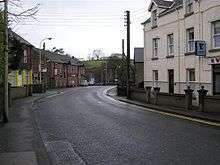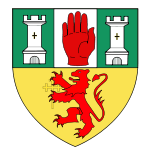Cullybackey
Cullybackey or Cullybacky (from Irish Coill na Baice, meaning 'wood of the river bend')[1] is a village in County Antrim, Northern Ireland. It lies 3 miles north-west of Ballymena, on the banks of the River Main, and is part of Mid and East Antrim district. It is a predominantly Protestant area. It had a population of 2,569 people in the 2011 Census.[2]

History
Cullybackey was part of the ancient kingdom of Dál nAraidi. Evidence of ancient dwellers in the area have been found throughout the years, including the remains of Crannogs and Souterrains.[3]
Christian Missionary Mackevet erected a monastery in the area. It is said that when Mackevet first approached the Irish Chieftain MacAfee about this matter the two began to argue over it and Mackevet, who was a large man raised his fist into the chieftains face and said "I'm a man of peace, but smell that MacAfee". This won him the argument and the monastery was built, supplying the area with a place of learning for many centuries afterwards.[4]
In 1778 a corps was raised by John Dickey of Cullybackey House, They named themselves 'The Cullybackey Volunteers'.[5]
In 1847, the village contained 235 residents and contained about 50 houses.[5]
Notable Cullybackey people
- Matilda Cullen Knowles, scientist, was born here in 1864.[6]
- Jessica Kurten, Olympic horse rider and representative of Ireland.
- Neil 'Smutty' Robinson, a well-known motorcycle racer and British 250cc Championship winner, who was killed, aged 24, in 1986.
- Steven Davis - Rangers and Northern Ireland Footballer.
- Ella Young, celtic poet, mythologist and Feminist activist was born here in 1867.[7]
Places of interest
- Arthur Cottage, the ancestral home of Chester A. Arthur, 21st President of the United States, from 1881 to 1885, is close to the village, on the B62 road from Ballymena. It is a restored 18th-century farmhouse with open flax-straw thatched roof. It is usually open to the public through the spring and summer months.
- The old Methodist church on the banks of the river was opened in 1839 as the Original Secession Church. It later became the United Free Church of Scotland. When the United Free clergy withdrew from Ireland in 1923, the congregation became Methodists.
- The Cuningham Memorial Presbyterian Church
- Craigs Church of Ireland, which was designed by celebrated 19th-century architect Sir Charles Lanyon and built in 1840. Attached to the church is a very old graveyard which contains 'The Strangers Plot', where the poor of the parish where buried, including those who lost their lives in the parish during the Great Famine (Ireland)
- Cullybackey Millennium Riverwalk [8]
- Galgorm Resort and Spa
- Craigdun Castle, a 19th-century Scottish baronial castle that is set a mile outside the village. Believed to have been designed by Charles Lanyon, it was left to the NHS as a home for multiple sclerosis sufferers in the 1950s and continued in this role until the 1990s, when it was sold by the NHS. The current owners have extensively renovated the property and gardens, and in 2011 the house was a finalist in the BBC Northern Ireland House of the Year programme.
Sport
- Cullybackey Blues Football Club[9]
Music
Groups and Associations
- Cullybackey Army Cadets
- Cullybackey Girls Brigade
- Cullybackey Scouts
- Cullybackey Girl Guides
- Cullybackey and District Historical Society
- Cullybackey British Legion
- Cullybackey Orange Order
- Cullybackey Women's Institute
- The 9:30 club
- Cullybackey Rocks
- Cullybackey Community Partnership
Transport
Translink (Northern Ireland) run both trains and bus's through the village daily.
The first sod on the Belfast railway line was turned in 1845 and the line from Ballymena to Portrush was completed in 1855 [10] The railway line is still well used by the population of Cullybackey today with trains stopping at the station almost hourly throughout the day.
There are bus stops at both ends and in the middle of the Main Street. bus stops are dotted around the surrounding townlands.
Education
- Cullybackey College
- Buick Memorial Primary School
- The Diamond Primary School
- Happitots pre-school
Demography
2011 Census
It had a population of 2,569 people (1,088 households) in the 2011 Census.[2] On Census day in 2011:
- 4.0% were from a Catholic background and 88.4% were from a Protestant background
2001 Census
Cullybackey is classified as an intermediate settlement by the NI Statistics and Research Agency (NISRA) (i.e., with population between 2,250 and 4,500 people). On Census day (29 April 2001) there were 2,405 people living in Cullybackey. Of these:
- 19.5% were aged under 16 and 22.3% were aged 60 and over
- 47.1% of the population were male and 52.9% were female
- 1.2% were from a Catholic background and 97.0% were from a Protestant background
- 3.3% of people aged 16–74 were unemployed.
For more details see: NI Neighbourhood Information Service
Controversies
In August 2005, the local Catholic church was attacked.[11]
17 February 2008 a house of a Polish family was attacked.[12]
In 2010 an upsurge in anti social behaviour and violence has been linked to paramilitary groups in the village.[13] However, after an investigation by the Police Service of Northern Ireland a statement was issued by a local police inspector who denied that paramilitaries were involved.[14]
See also
| Wikimedia Commons has media related to Cullybackey. |
- List of villages in Northern Ireland
- List of towns in Northern Ireland
References
- Archived July 17, 2011, at the Wayback Machine
- "Cullybackey". Census 2011 Results. NI Statistics and Research Agency. Retrieved 30 April 2015.
- W. J., Knowles (April 1905). "Souterrains at Cullybackey, in the County of Antrim". Ulster Journal of Archaeology. Second. 11: 51–54. JSTOR 20566211.
- Shaw, William (1912). Cullybackey and District. Ballymena Borough Council. p. 4.
- Lewis, Samuel (1837). A topographical dictionary of Ireland. S. Lewis, 1837. p. 443.
- "Ask About Ireland – Irish Scientists – Matilda Knowles". Ask About Ireland – Irish Scientists. Retrieved 2 November 2014.
- "Ella Young". Cullybackey and District Historical Society.
- "Maine Riverside". Walk NI. 2010-07-11. Retrieved 2015-10-22.
- "Cullybackey Blues FC". Facebook.
- Cullybackey and District by William Shaw
- "News". An Phoblacht. 2015-10-01. Retrieved 2015-10-22.
- "Polak na Wyspie - Koktajlem Mołotowa w Polaków - strona 1" (in Polish). MojaWyspa.co.uk. 2008-02-17. Retrieved 2015-10-22.
- "Paramilitary link to street violence - Belfast Newsletter". Newsletter.co.uk. 2010-11-22. Retrieved 2015-10-22.
- "'No paramilitaries' involved in Cullybackey fracas - DPP told". Ballymena Times. Retrieved 2015-10-22.
